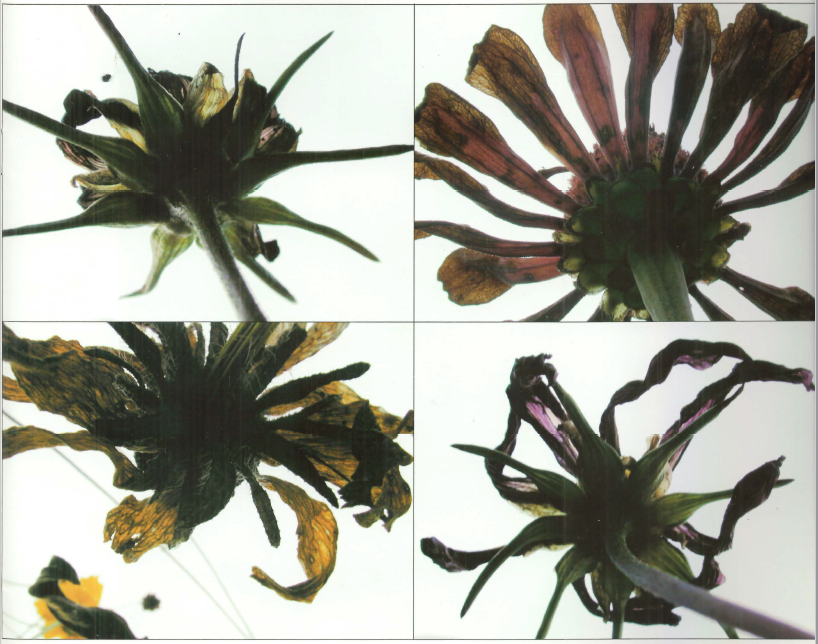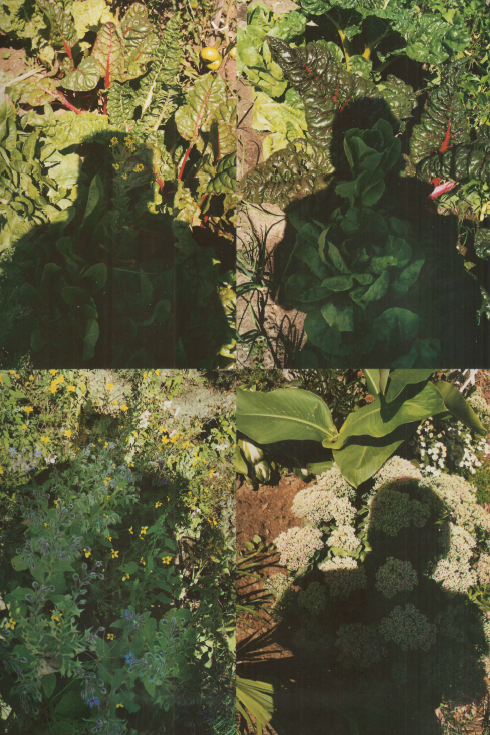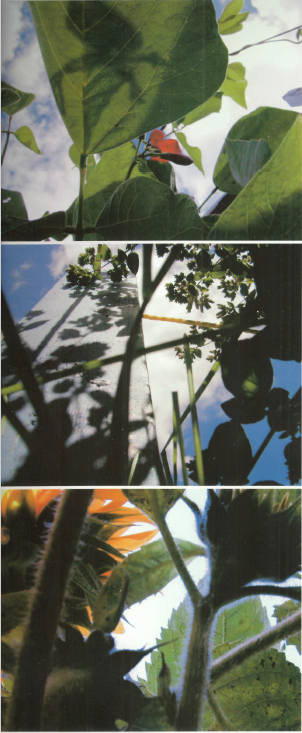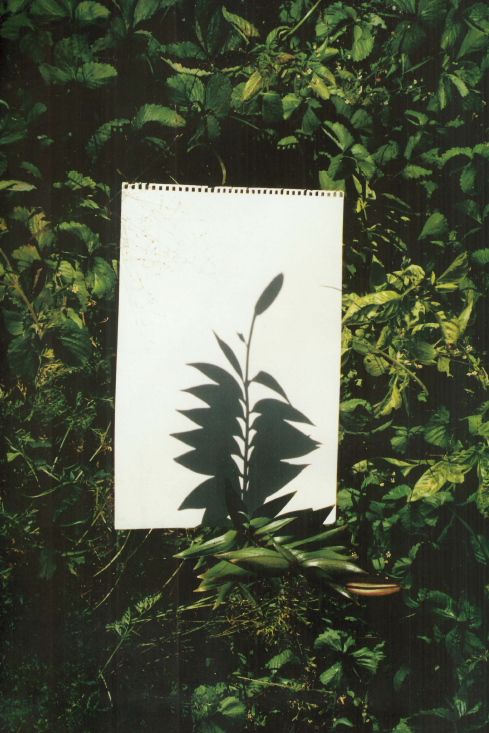Under a Campeau Blue Sky (2001)

Graham, Robert. (2001). Under a Campeau Blue Sky. CV Photo, 54, pp. 15-22.Arborescences
… a late-summer bounty of natural and unnatural growth, the cultivated and the uncontrollable. For while this garden has its real-world aspect and can be found on a map, it serves for Campeau as the foliage in a narrative tour of an interior landscape, described in muted speech and in surroundings of symbolic figuration.
“Midway this way of life we’re bound upon, I woke to find myself in a dark wood.. .” 1
The renewal requires a death. Specifically, the second life, the new alternate life that comes with middle age, requires the identity-death of the child past, the symbolic figure of the immature being. So, Michel Campeau begins his new multi-part project Arboresccnces (2000) showing a young girl busy writing, and then he invokes an earlier picture set in a cemetery in which a barren tree shadow falls across the rocky ground, in the upper corner of which is the open maw of a freshly dug grave. Following the sombre bass note of this prologue, Campeau enters in full throat to sing a song of triumphant fertility, in the first section called “Les croissances et les excroissances.” But this is not nature in its large raw setting, but in an urban garden in Montreal. 2 While the vegetation shown is a domesticated crop supported and constrained by posts and guide strings, it is also various and with huge leaves, a late-summer bounty of natural and unnatural growth, the cultivated and the uncontrollable. For while this garden has its real-world aspect and can be found on a map, it serves for Campeau as the foliage in a narrative tour of an interior landscape, described in muted speech and in surroundings of symbolic figuration.

Into this happy Arcadian scene comes shuffling the figure of the artist – but as a shadow, “L’ombre de soi-même.” In picture after picture, the photographer’s shadow is cast over the ground and covers the growth. The ground is inhabited by the photographer’s shadow, which draws out his shape. Playfully erudite, Campeau is acknowledging Lee Friedlander’s self-portrait work, and in the way he reconstitutes himself in the plants and flowers he echoes the fruit-and vegetable figures of Giuseppe Arcimboldo.
Initially in black and white, the shadow self-portrait series breaks out into colour: yellow, red and pink, white, and, of course, a variety of greens. This is the displayed symbolic ground of the emotive interior. For the photographer, the world as photographed becomes autobiographical, with the pictorial elements serving as image-objects and symbolic tokens of the artist’s life and extensions of his consciousness. Not the photography of recorded observation, but the photography of feelings portrayed through the use of light and dark: photo-emotions (emotions experienced by picture- taker and picture-viewer alike).
In the language of Jungian analysis, “The persona-shadow dialogue at midlife represents a necessary building of the personality between the Realpolitik of society and the truth of the individual.”3 The shadow is the ground upon which is played out the act of psychic renewal and from which emerges the newly formed identity. “The shadow contains all that is vital yet problematic – anger and sexuality, to be sure, but also joy, spontaneity and untapped creative fires.”4
Like Picasso’s Vollard Suite (1930-37), Arborescences is the work of a mature artist and a middle-aged man’s study of love, sex, health, and mortality – refracted indirectly through a natural world. The source of Picasso’s image language was the world of an open-air studio occupied by models, himself, and beasts – both real and imaginary. For Campeau it is the garden world of plants and bugs, and memories mediated photographically. In particular, the photographer finds that light is redemptive, and, like one of his beloved plants, he turns hungrily toward it. Following a fallow period, Campeau has been rejuvenated by the distinct effects and possibilities of the digital camera and the ink-jet printer.

In the section entitled “La posture de l’insecte,” the camera is held underneath the plants, showing the perspective of a bug: the big juicy plant leaf with the sun bearing down on it and the radiant sky above. Greatly magnified, the hairy leaves and out-of-control tendrils acknowledge the close-up-plant still-lifes of German photographer Karl Blossfeldt, which Walter Benjamin found so revealing. Magnified and close up, this is a different world than the one we know. The hand-view camera shows what was never seen. It is not “pre-viewed” and then recorded but the report back of what the camera, as a kind of probe, discovered. It is from such novel views that new insights can be found.
And the sky! The first time I turned the page onto that deeply coloured sky, I laughed out loud. This was the happy appearance of a creamy blue sky that now, when I see it in nature, I think of as being “Campeau blue.”
But the joy and pleasure-seeking aspects are not without their dark counterparts. In the section called “Flétrissures” the light is not universally distributed and there are shadow areas marking regions of dark that occupy aspects of the pictures as circular zones or the crisscrossing of stems. In its entirety, Arborescences could be viewed as a demonstration of the expressive use of shadow as a constituent form, of the ways in which shadows become “incorporated” as if they were bodies or had mass. And, conversely, how physical matter can be portrayed as the “negative light” of a shadow.

In a section entitled “La nature invisible,” Campeau introduces a sheet of white drawing paper to the scene. The sheet is put on the ground among the plants and serves as a field for the plants’ shadows and a background for the plants themselves. Here, both the shadow and the thing are present simultaneously as the viewer’s vision oscillates between them.
Campeau completes his narrative with a set of pictures in which a mirror is put among the plants and they and the sky above are reflected in it. Plants hover over the surface and thus are doubly seen. These images are like recapitulations, recollections. Holding other pictures over the mirror (we see his hand in the reflection), Campeau explodes the space and we are brought into the other dimension of time. An old photo of the photographer and his partner, Nicole, is suspended in the mirror like a passing cloud. This series is called “Les angles d’incidence.”
Like all of Campeau’s work, Arborescences demonstrates how a life can be explored through photography. As a son, husband, father, colleague, citizen, and much else, he experiences his many roles through the specific prism of photographic imaging. This is not simply documenting the surrounding life as it occurs, but an existential acceptance of his life destiny as a photographer. The work is the record of a human response to world encounters as emotional, questioning, aiding, and constructing mediations. As such, there are things about the conjunction of photography and life that we can learn from this man.
by Robert Graham
Notes
- Dante Alighieri, The Divine Comedy: Hell, trans. Dorothy L. Sayers (Harmondsworth: Penguin, 1969), p. 71.
- These are actually quite special democratically expressive places, the result of “gardening guerrillas” who, in the 1970s, took over abandoned city lots for cultivation. See Margo Pfeiff, “City of Gardens,” Canadian Geographic, Vol. 121, No. 1 Jan.-Feb. 2001), pp. 64-72.
- James Hollis, The Middle Passage: from Misery to Meaning in Midlife (Toronto: Inner City Books, 1993), p. 42.
- Ibid., p. 43.
Resumé
L’auteur décrit Arborescences, le nouveau projet de Michel Campeau, comme une exploration photographique de la transition symbolique interieure propre a la cinquantaine. Campeau explore un paysage végétatif riche et fertile où ii trouve, à partir de sa memoire de citations artistiques et de vues originales, les éléments d’une nouvelle vie. Explorant d’abord la figure de son ombre au sol, il adopte ensuite le point de vue de l’insecte sur la vie des plantes et découvre une succulence profusion en decoupe centre un ciel bleu crème (le «bleu Campeau»), puis il capte les ombres créées par le feuillage sur une feuille de papier; quand ce ne sont pas les reflets d’un miroir. Explorateur de la psyché, le photographe se tient au croisement de sa photographie et de sa vie et nous transmet ses découvertes.